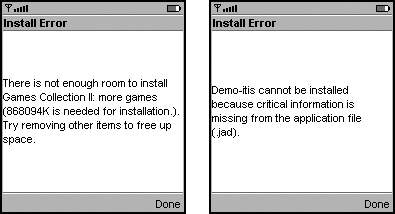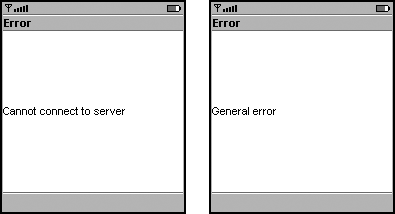Handling app Management Errors
The MIDP 2.0 Specification [19] mandates that the user be informed of certain app management errors. In other cases, a MIDP implementation should only inform the user of critical errors. This applies the advice, "Minimize Interruptions From MIDP and MIDlets" on page 13.
MIDP Implementors
Strongly Recommend:
When you tell users about a problem, provide error messages that they can understand and, if appropriate, can act on in order to fix the problem. Useful error messages include the following information:
- What's wrong; for example, "The server cannot accept your request at this time."
- Why it's wrong, if you know and can tell them in a meaningful way; for example, "This could happen if the system is too busy."
- What to do about it; for example, "Try again later."
Make a distinction between a problem with the device (such as a low battery), with the server (such as an unavailable JAR file), with the connection (such as a dropped connection), and with data transmission (such as getting corrupt data). Screenshot shows an example of a good error message.
Screenshot Good Error Message

Screenshot shows examples of poor error messages. The error message on the left is too terse. It tells the user what the problem is, but it doesn't tell the user why the problem might have occurred or what to do about it. The error message on the right has the same problem, and in addition, it does not tell the user what problem occurred.
Screenshot Not Recommended: Poor Error Messages
